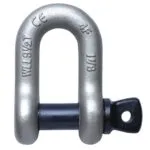Understanding the Difference Between Bow Shackles and Dee Shackles
Shackles are a vital component in various industries, including maritime, construction, demolition and manufacturing, where heavy lifting and securing loads are routine tasks. Among the different types of shackles available, bow shackles and dee shackles are two of the most commonly used varieties. While they may appear similar at first glance, each type serves specific purposes, and understanding their differences is crucial for selecting the appropriate shackle for a particular application.
Bow Shackles:
Bow shackles, also known as anchor shackles, derive their name from the shape of their bows or curved bodies. These shackles feature a U-shaped design with a slightly bowed shape, resembling a bow tie. The curved shape of the bow allows for better load distribution, making them ideal for applications involving angular lifts or multiple connection points.
Key Characteristics of Bow Shackles:
- Versatility: Bow shackles are versatile and can accommodate a wide range of rigging configurations, including multi-leg slings and bridles.
- Load Distribution: The bowed shape of the shackle helps distribute the load more evenly across the shackle, reducing stress concentrations.
- Angular Loads: Bow shackles are particularly well-suited for applications involving angular lifts, where the load may pull from different directions.
- Higher Working Load Limit (WLL): In general, bow shackles tend to have a higher working load limit compared to dee shackles of similar sizes.
Dee Shackle
Dee shackles, also referred to as chain shackles or D shackles, are characterised by their “D” or horseshoe-shaped design. These shackles have a straight pin across the top of the shackle body, forming the straight side of the “D” shape. Dee shackles are commonly used for straightforward, in-line lifting applications where the load is primarily vertical.
Key Characteristics of Dee Shackles:
- Straightforward Design: Dee shackles have a simple, straight-forward design, making them easy to use and inspect.
- Vertical Loads: These shackles are best suited for applications where the load is predominantly vertical, such as lifting a heavy object with a single-point connection.
- Space Limitations: Dee shackles are often preferred in applications where space is limited, as their compact design allows for easier fitting into tight spaces.
- Cost-Effectiveness: Dee shackles are generally more cost-effective compared to bow shackles, making them a preferred choice for simpler lifting tasks.
Choosing the Right Shackle:
When selecting between bow shackles and dee shackles, it’s essential to consider the specific requirements of the lifting or rigging application. Factors such as the direction of the load, the presence of angular pulls, space limitations, and the required working load limit all play a crucial role in determining the most suitable shackle for the job.
In summary, bow shackles are preferred for applications involving angular loads, multi-leg slings, and situations where load distribution is critical, while dee shackles are more suitable for straightforward, vertical lifting tasks with space constraints. Understanding the differences between these two types of shackles enables professionals to make informed decisions, ensuring safe and efficient lifting operations across various industries.
Your sites will need the following personal to carry out lifting operations. Contact Vally Plant training
Appointed Person Training
An Appointed Person for lifting is tasked with planning, organising, and supervising lifting operations to ensure they are carried out safely and effectively. They assess the lifting requirements, select appropriate equipment, coordinate personnel, conduct risk assessments, and ensure compliance with safety regulations. The Appointed Person plays a critical role in maintaining safety standards and ensuring that lifting activities are conducted with precision and efficiency.
Lift Supervisor Training
A lift supervisor oversees and manages lifting operations, ensuring they are conducted safely and efficiently. Responsibilities include planning, safety compliance, supervision of personnel, risk assessment, communication, problem-solving, and documentation. They play a crucial role in maintaining safety standards and coordinating lifting activities on-site.
Slinger Signaller Training
A slinger signaller assists crane operators in safely manoeuvring loads on construction sites or industrial settings. Responsibilities include preparing loads for lifting, signalling crane movements using standardised hand signals, ensuring safety protocols are followed, communicating with team members, assisting with rigging, conducting risk assessments, and maintaining documentation of lifting activities. They play a critical role in ensuring that lifting operations are conducted safely and efficiently. About NPORS Slinger Signaller Training




